Toxicology 3 Assignment: Health and Safety in Occupational Settings
VerifiedAdded on 2022/08/22
|10
|2309
|13
Homework Assignment
AI Summary
This Toxicology 3 assignment delves into various facets of occupational health and safety. It begins by defining key terms such as health, hygiene, safety, and occupational hygiene, and then distinguishes between occupational safety and health. The assignment explores different types of occupational hazards, including physical, chemical, biological, radiological, and ergonomic hazards, and provides examples of each. It also discusses occupational diseases caused by various agents and the routes of exposure to chemicals like benzene. Furthermore, it addresses the levels of occupational exposure effects, including acceptable and hazardous levels. The assignment then explores exposure control methods, including primary, secondary, and tertiary measures. It also covers the effects of different chemicals and gasses, including petroleum products, heavy metals, and pesticides. The assignment further details the mechanisms of toxic substance entry, including diffusion and active transport, and explains mutagenic and teratogenic agents. It also explores the role of biological, chemical, ergonomic, and psychosocial factors in occupational diseases. Defense mechanisms of the human body against toxins are discussed, as well as the concepts of toxicokinetics, biotransformation, and bioaccumulation. The assignment also addresses methods to prevent occupational illness and the significance of LD50, LC50, TLV, TWA, STEL, and IDLH values. Finally, the assignment includes an example of a Material Safety Data Sheet (MSDS) for Xylene, covering its properties, hazards, and safety measures.

Toxicology
Student’s Details
Student’s Details
Paraphrase This Document
Need a fresh take? Get an instant paraphrase of this document with our AI Paraphraser
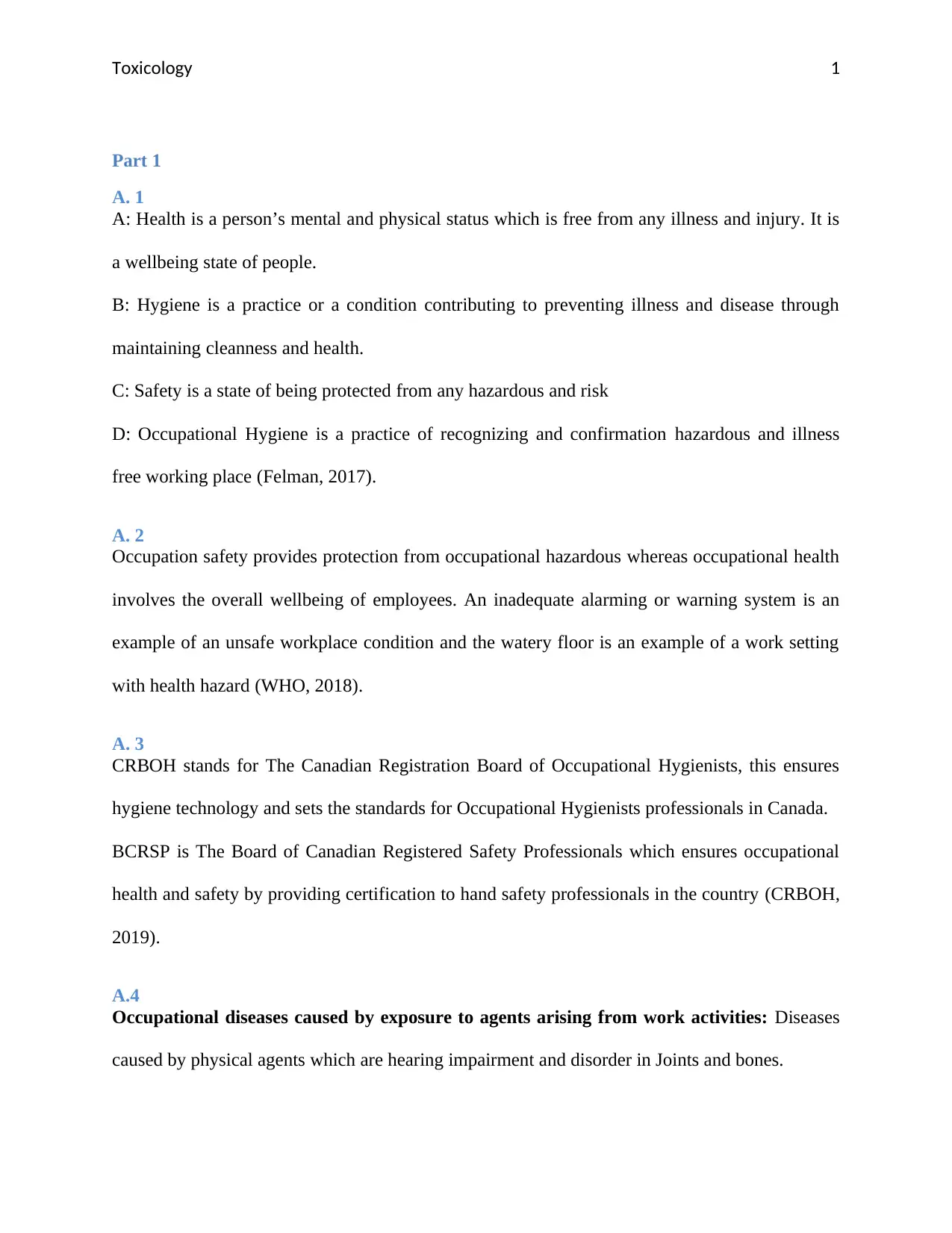
Toxicology 1
Part 1
A. 1
A: Health is a person’s mental and physical status which is free from any illness and injury. It is
a wellbeing state of people.
B: Hygiene is a practice or a condition contributing to preventing illness and disease through
maintaining cleanness and health.
C: Safety is a state of being protected from any hazardous and risk
D: Occupational Hygiene is a practice of recognizing and confirmation hazardous and illness
free working place (Felman, 2017).
A. 2
Occupation safety provides protection from occupational hazardous whereas occupational health
involves the overall wellbeing of employees. An inadequate alarming or warning system is an
example of an unsafe workplace condition and the watery floor is an example of a work setting
with health hazard (WHO, 2018).
A. 3
CRBOH stands for The Canadian Registration Board of Occupational Hygienists, this ensures
hygiene technology and sets the standards for Occupational Hygienists professionals in Canada.
BCRSP is The Board of Canadian Registered Safety Professionals which ensures occupational
health and safety by providing certification to hand safety professionals in the country (CRBOH,
2019).
A.4
Occupational diseases caused by exposure to agents arising from work activities: Diseases
caused by physical agents which are hearing impairment and disorder in Joints and bones.
Part 1
A. 1
A: Health is a person’s mental and physical status which is free from any illness and injury. It is
a wellbeing state of people.
B: Hygiene is a practice or a condition contributing to preventing illness and disease through
maintaining cleanness and health.
C: Safety is a state of being protected from any hazardous and risk
D: Occupational Hygiene is a practice of recognizing and confirmation hazardous and illness
free working place (Felman, 2017).
A. 2
Occupation safety provides protection from occupational hazardous whereas occupational health
involves the overall wellbeing of employees. An inadequate alarming or warning system is an
example of an unsafe workplace condition and the watery floor is an example of a work setting
with health hazard (WHO, 2018).
A. 3
CRBOH stands for The Canadian Registration Board of Occupational Hygienists, this ensures
hygiene technology and sets the standards for Occupational Hygienists professionals in Canada.
BCRSP is The Board of Canadian Registered Safety Professionals which ensures occupational
health and safety by providing certification to hand safety professionals in the country (CRBOH,
2019).
A.4
Occupational diseases caused by exposure to agents arising from work activities: Diseases
caused by physical agents which are hearing impairment and disorder in Joints and bones.
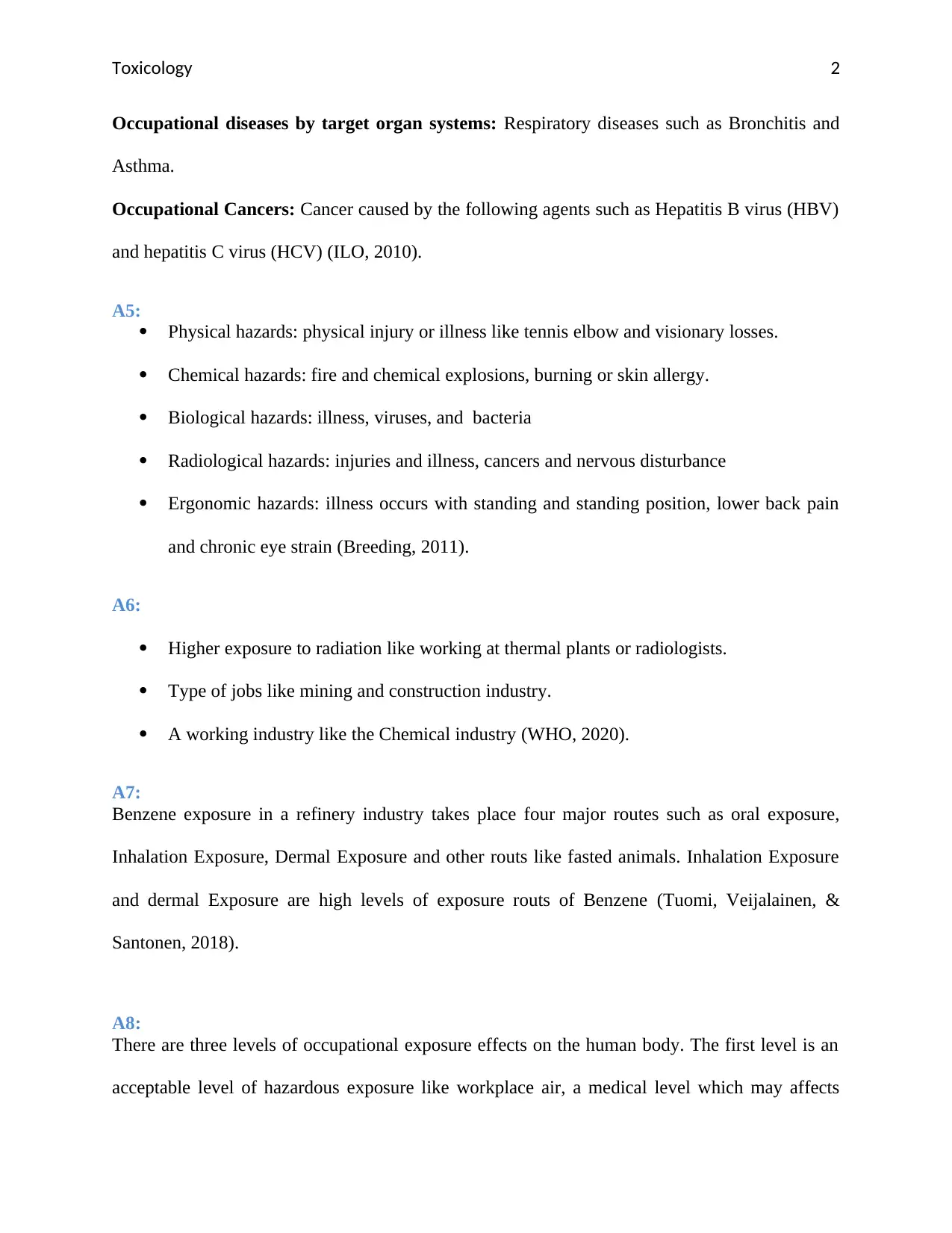
Toxicology 2
Occupational diseases by target organ systems: Respiratory diseases such as Bronchitis and
Asthma.
Occupational Cancers: Cancer caused by the following agents such as Hepatitis B virus (HBV)
and hepatitis C virus (HCV) (ILO, 2010).
A5:
Physical hazards: physical injury or illness like tennis elbow and visionary losses.
Chemical hazards: fire and chemical explosions, burning or skin allergy.
Biological hazards: illness, viruses, and bacteria
Radiological hazards: injuries and illness, cancers and nervous disturbance
Ergonomic hazards: illness occurs with standing and standing position, lower back pain
and chronic eye strain (Breeding, 2011).
A6:
Higher exposure to radiation like working at thermal plants or radiologists.
Type of jobs like mining and construction industry.
A working industry like the Chemical industry (WHO, 2020).
A7:
Benzene exposure in a refinery industry takes place four major routes such as oral exposure,
Inhalation Exposure, Dermal Exposure and other routs like fasted animals. Inhalation Exposure
and dermal Exposure are high levels of exposure routs of Benzene (Tuomi, Veijalainen, &
Santonen, 2018).
A8:
There are three levels of occupational exposure effects on the human body. The first level is an
acceptable level of hazardous exposure like workplace air, a medical level which may affects
Occupational diseases by target organ systems: Respiratory diseases such as Bronchitis and
Asthma.
Occupational Cancers: Cancer caused by the following agents such as Hepatitis B virus (HBV)
and hepatitis C virus (HCV) (ILO, 2010).
A5:
Physical hazards: physical injury or illness like tennis elbow and visionary losses.
Chemical hazards: fire and chemical explosions, burning or skin allergy.
Biological hazards: illness, viruses, and bacteria
Radiological hazards: injuries and illness, cancers and nervous disturbance
Ergonomic hazards: illness occurs with standing and standing position, lower back pain
and chronic eye strain (Breeding, 2011).
A6:
Higher exposure to radiation like working at thermal plants or radiologists.
Type of jobs like mining and construction industry.
A working industry like the Chemical industry (WHO, 2020).
A7:
Benzene exposure in a refinery industry takes place four major routes such as oral exposure,
Inhalation Exposure, Dermal Exposure and other routs like fasted animals. Inhalation Exposure
and dermal Exposure are high levels of exposure routs of Benzene (Tuomi, Veijalainen, &
Santonen, 2018).
A8:
There are three levels of occupational exposure effects on the human body. The first level is an
acceptable level of hazardous exposure like workplace air, a medical level which may affects
⊘ This is a preview!⊘
Do you want full access?
Subscribe today to unlock all pages.

Trusted by 1+ million students worldwide
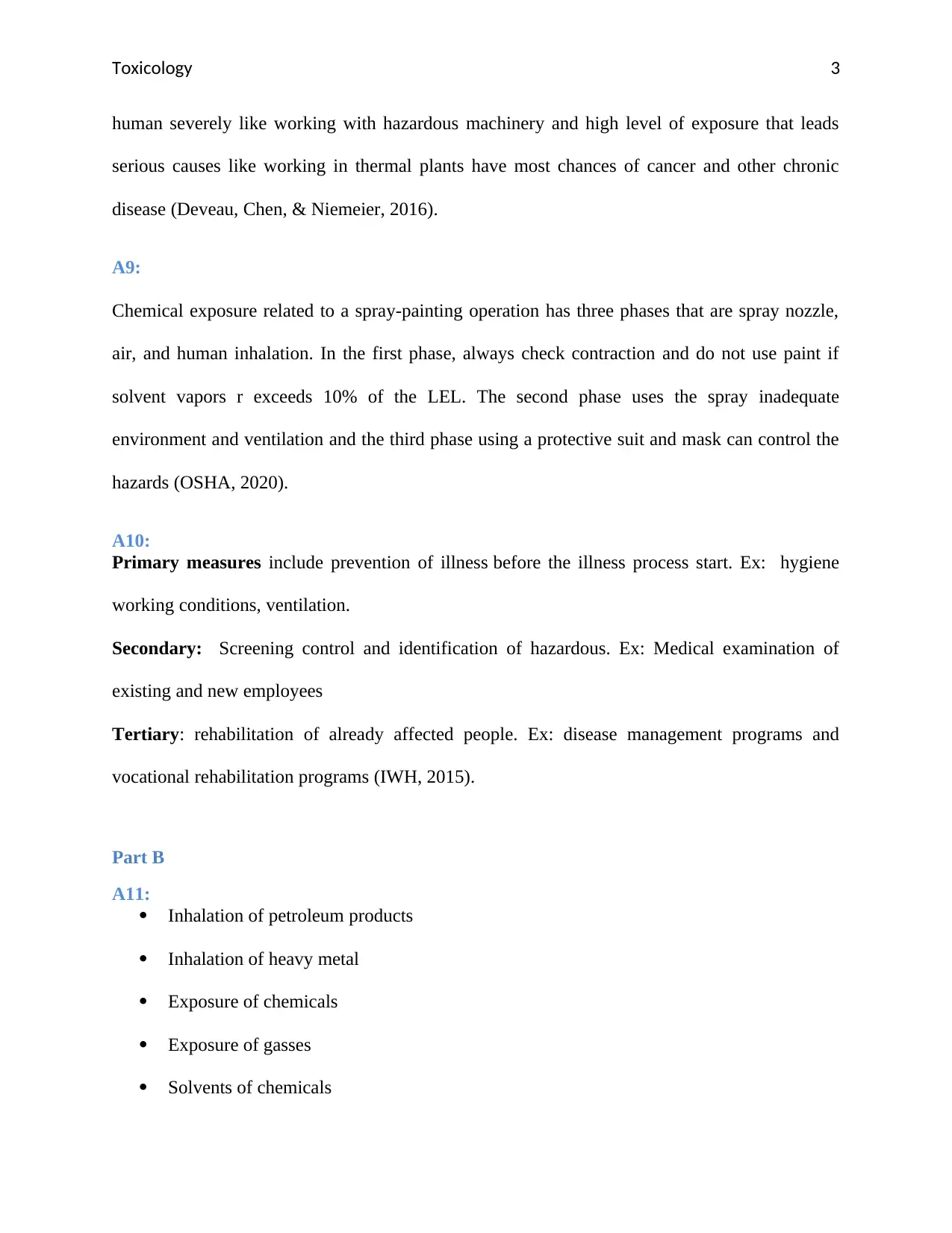
Toxicology 3
human severely like working with hazardous machinery and high level of exposure that leads
serious causes like working in thermal plants have most chances of cancer and other chronic
disease (Deveau, Chen, & Niemeier, 2016).
A9:
Chemical exposure related to a spray-painting operation has three phases that are spray nozzle,
air, and human inhalation. In the first phase, always check contraction and do not use paint if
solvent vapors r exceeds 10% of the LEL. The second phase uses the spray inadequate
environment and ventilation and the third phase using a protective suit and mask can control the
hazards (OSHA, 2020).
A10:
Primary measures include prevention of illness before the illness process start. Ex: hygiene
working conditions, ventilation.
Secondary: Screening control and identification of hazardous. Ex: Medical examination of
existing and new employees
Tertiary: rehabilitation of already affected people. Ex: disease management programs and
vocational rehabilitation programs (IWH, 2015).
Part B
A11:
Inhalation of petroleum products
Inhalation of heavy metal
Exposure of chemicals
Exposure of gasses
Solvents of chemicals
human severely like working with hazardous machinery and high level of exposure that leads
serious causes like working in thermal plants have most chances of cancer and other chronic
disease (Deveau, Chen, & Niemeier, 2016).
A9:
Chemical exposure related to a spray-painting operation has three phases that are spray nozzle,
air, and human inhalation. In the first phase, always check contraction and do not use paint if
solvent vapors r exceeds 10% of the LEL. The second phase uses the spray inadequate
environment and ventilation and the third phase using a protective suit and mask can control the
hazards (OSHA, 2020).
A10:
Primary measures include prevention of illness before the illness process start. Ex: hygiene
working conditions, ventilation.
Secondary: Screening control and identification of hazardous. Ex: Medical examination of
existing and new employees
Tertiary: rehabilitation of already affected people. Ex: disease management programs and
vocational rehabilitation programs (IWH, 2015).
Part B
A11:
Inhalation of petroleum products
Inhalation of heavy metal
Exposure of chemicals
Exposure of gasses
Solvents of chemicals
Paraphrase This Document
Need a fresh take? Get an instant paraphrase of this document with our AI Paraphraser
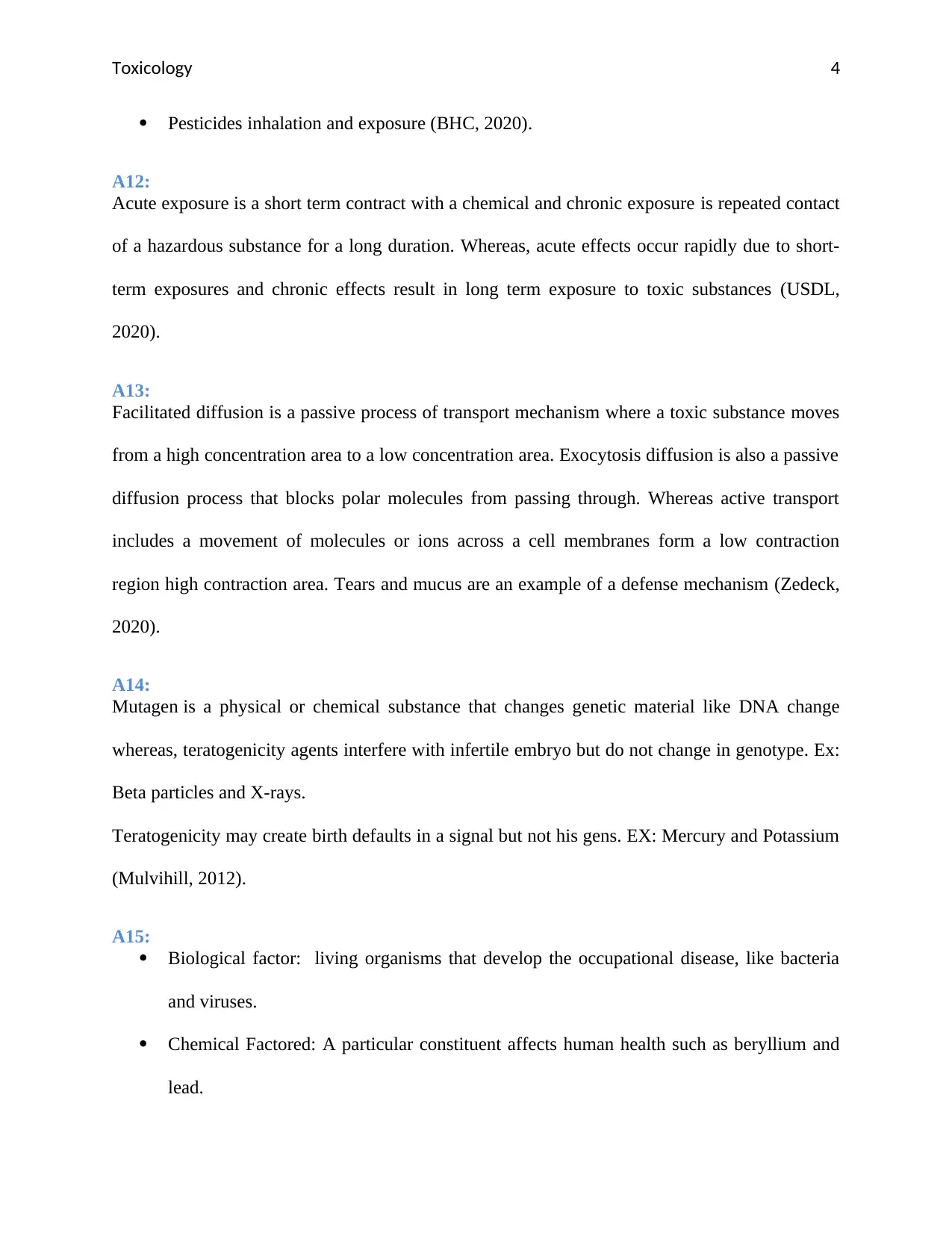
Toxicology 4
Pesticides inhalation and exposure (BHC, 2020).
A12:
Acute exposure is a short term contract with a chemical and chronic exposure is repeated contact
of a hazardous substance for a long duration. Whereas, acute effects occur rapidly due to short-
term exposures and chronic effects result in long term exposure to toxic substances (USDL,
2020).
A13:
Facilitated diffusion is a passive process of transport mechanism where a toxic substance moves
from a high concentration area to a low concentration area. Exocytosis diffusion is also a passive
diffusion process that blocks polar molecules from passing through. Whereas active transport
includes a movement of molecules or ions across a cell membranes form a low contraction
region high contraction area. Tears and mucus are an example of a defense mechanism (Zedeck,
2020).
A14:
Mutagen is a physical or chemical substance that changes genetic material like DNA change
whereas, teratogenicity agents interfere with infertile embryo but do not change in genotype. Ex:
Beta particles and X-rays.
Teratogenicity may create birth defaults in a signal but not his gens. EX: Mercury and Potassium
(Mulvihill, 2012).
A15:
Biological factor: living organisms that develop the occupational disease, like bacteria
and viruses.
Chemical Factored: A particular constituent affects human health such as beryllium and
lead.
Pesticides inhalation and exposure (BHC, 2020).
A12:
Acute exposure is a short term contract with a chemical and chronic exposure is repeated contact
of a hazardous substance for a long duration. Whereas, acute effects occur rapidly due to short-
term exposures and chronic effects result in long term exposure to toxic substances (USDL,
2020).
A13:
Facilitated diffusion is a passive process of transport mechanism where a toxic substance moves
from a high concentration area to a low concentration area. Exocytosis diffusion is also a passive
diffusion process that blocks polar molecules from passing through. Whereas active transport
includes a movement of molecules or ions across a cell membranes form a low contraction
region high contraction area. Tears and mucus are an example of a defense mechanism (Zedeck,
2020).
A14:
Mutagen is a physical or chemical substance that changes genetic material like DNA change
whereas, teratogenicity agents interfere with infertile embryo but do not change in genotype. Ex:
Beta particles and X-rays.
Teratogenicity may create birth defaults in a signal but not his gens. EX: Mercury and Potassium
(Mulvihill, 2012).
A15:
Biological factor: living organisms that develop the occupational disease, like bacteria
and viruses.
Chemical Factored: A particular constituent affects human health such as beryllium and
lead.
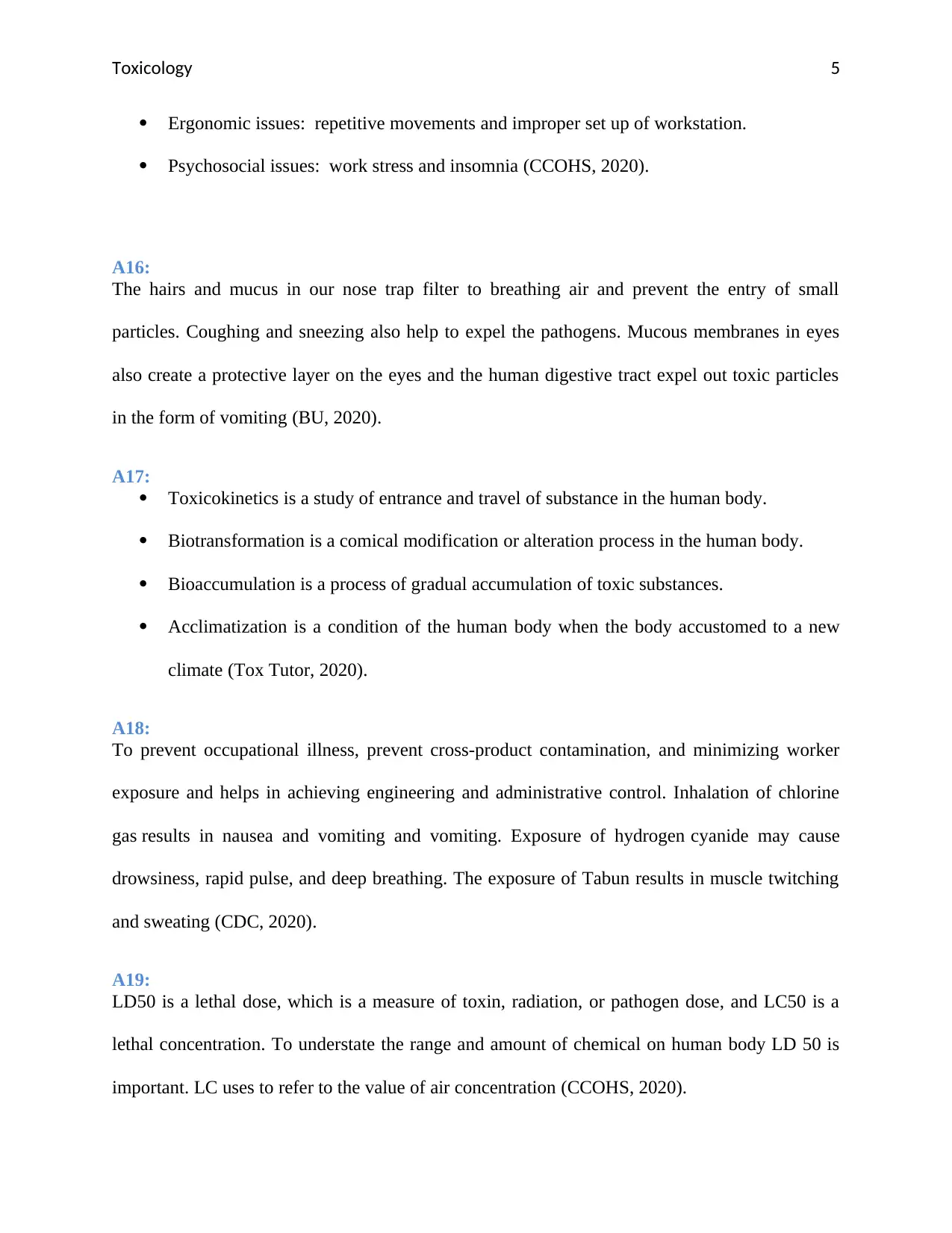
Toxicology 5
Ergonomic issues: repetitive movements and improper set up of workstation.
Psychosocial issues: work stress and insomnia (CCOHS, 2020).
A16:
The hairs and mucus in our nose trap filter to breathing air and prevent the entry of small
particles. Coughing and sneezing also help to expel the pathogens. Mucous membranes in eyes
also create a protective layer on the eyes and the human digestive tract expel out toxic particles
in the form of vomiting (BU, 2020).
A17:
Toxicokinetics is a study of entrance and travel of substance in the human body.
Biotransformation is a comical modification or alteration process in the human body.
Bioaccumulation is a process of gradual accumulation of toxic substances.
Acclimatization is a condition of the human body when the body accustomed to a new
climate (Tox Tutor, 2020).
A18:
To prevent occupational illness, prevent cross-product contamination, and minimizing worker
exposure and helps in achieving engineering and administrative control. Inhalation of chlorine
gas results in nausea and vomiting and vomiting. Exposure of hydrogen cyanide may cause
drowsiness, rapid pulse, and deep breathing. The exposure of Tabun results in muscle twitching
and sweating (CDC, 2020).
A19:
LD50 is a lethal dose, which is a measure of toxin, radiation, or pathogen dose, and LC50 is a
lethal concentration. To understate the range and amount of chemical on human body LD 50 is
important. LC uses to refer to the value of air concentration (CCOHS, 2020).
Ergonomic issues: repetitive movements and improper set up of workstation.
Psychosocial issues: work stress and insomnia (CCOHS, 2020).
A16:
The hairs and mucus in our nose trap filter to breathing air and prevent the entry of small
particles. Coughing and sneezing also help to expel the pathogens. Mucous membranes in eyes
also create a protective layer on the eyes and the human digestive tract expel out toxic particles
in the form of vomiting (BU, 2020).
A17:
Toxicokinetics is a study of entrance and travel of substance in the human body.
Biotransformation is a comical modification or alteration process in the human body.
Bioaccumulation is a process of gradual accumulation of toxic substances.
Acclimatization is a condition of the human body when the body accustomed to a new
climate (Tox Tutor, 2020).
A18:
To prevent occupational illness, prevent cross-product contamination, and minimizing worker
exposure and helps in achieving engineering and administrative control. Inhalation of chlorine
gas results in nausea and vomiting and vomiting. Exposure of hydrogen cyanide may cause
drowsiness, rapid pulse, and deep breathing. The exposure of Tabun results in muscle twitching
and sweating (CDC, 2020).
A19:
LD50 is a lethal dose, which is a measure of toxin, radiation, or pathogen dose, and LC50 is a
lethal concentration. To understate the range and amount of chemical on human body LD 50 is
important. LC uses to refer to the value of air concentration (CCOHS, 2020).
⊘ This is a preview!⊘
Do you want full access?
Subscribe today to unlock all pages.

Trusted by 1+ million students worldwide
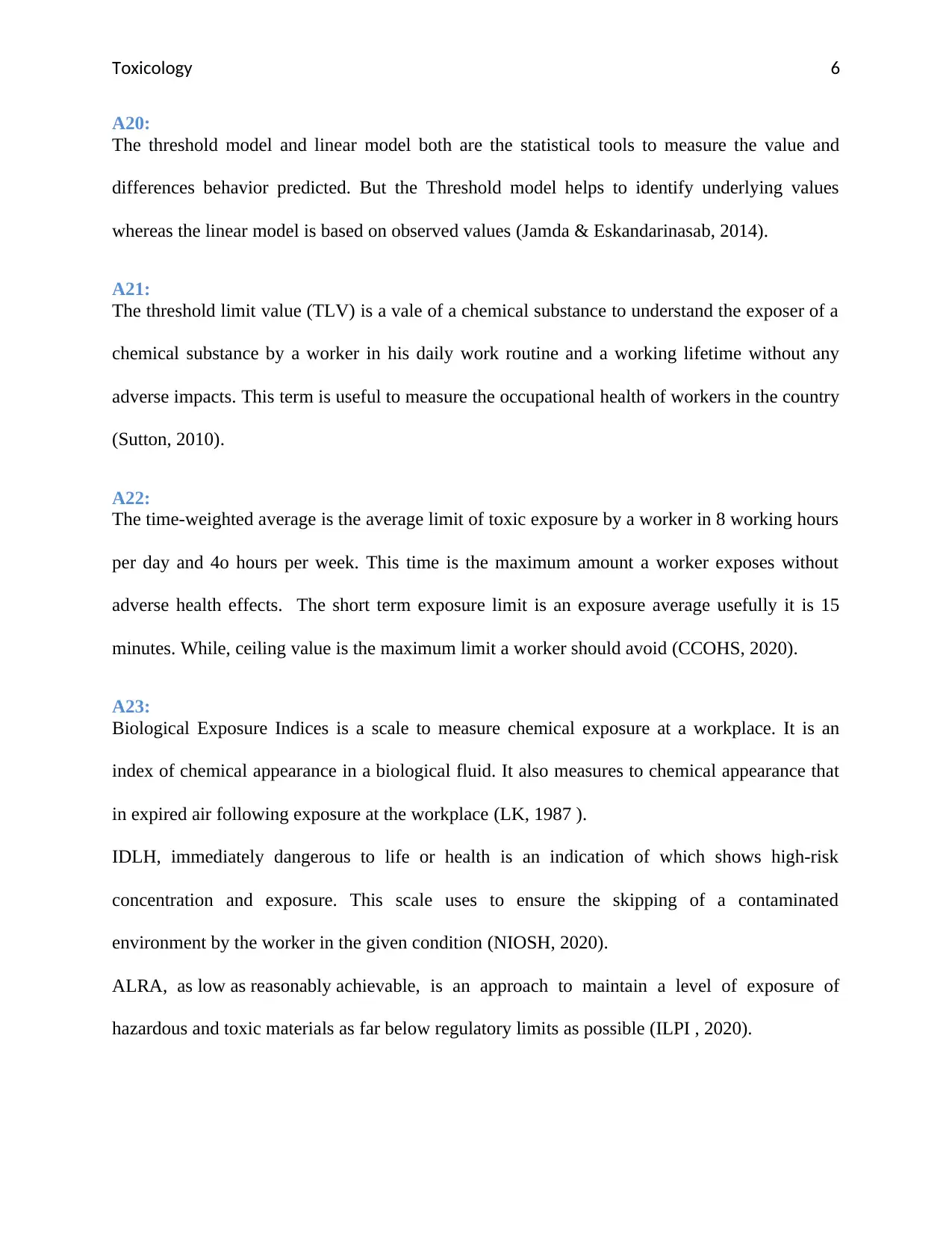
Toxicology 6
A20:
The threshold model and linear model both are the statistical tools to measure the value and
differences behavior predicted. But the Threshold model helps to identify underlying values
whereas the linear model is based on observed values (Jamda & Eskandarinasab, 2014).
A21:
The threshold limit value (TLV) is a vale of a chemical substance to understand the exposer of a
chemical substance by a worker in his daily work routine and a working lifetime without any
adverse impacts. This term is useful to measure the occupational health of workers in the country
(Sutton, 2010).
A22:
The time-weighted average is the average limit of toxic exposure by a worker in 8 working hours
per day and 4o hours per week. This time is the maximum amount a worker exposes without
adverse health effects. The short term exposure limit is an exposure average usefully it is 15
minutes. While, ceiling value is the maximum limit a worker should avoid (CCOHS, 2020).
A23:
Biological Exposure Indices is a scale to measure chemical exposure at a workplace. It is an
index of chemical appearance in a biological fluid. It also measures to chemical appearance that
in expired air following exposure at the workplace (LK, 1987 ).
IDLH, immediately dangerous to life or health is an indication of which shows high-risk
concentration and exposure. This scale uses to ensure the skipping of a contaminated
environment by the worker in the given condition (NIOSH, 2020).
ALRA, as low as reasonably achievable, is an approach to maintain a level of exposure of
hazardous and toxic materials as far below regulatory limits as possible (ILPI , 2020).
A20:
The threshold model and linear model both are the statistical tools to measure the value and
differences behavior predicted. But the Threshold model helps to identify underlying values
whereas the linear model is based on observed values (Jamda & Eskandarinasab, 2014).
A21:
The threshold limit value (TLV) is a vale of a chemical substance to understand the exposer of a
chemical substance by a worker in his daily work routine and a working lifetime without any
adverse impacts. This term is useful to measure the occupational health of workers in the country
(Sutton, 2010).
A22:
The time-weighted average is the average limit of toxic exposure by a worker in 8 working hours
per day and 4o hours per week. This time is the maximum amount a worker exposes without
adverse health effects. The short term exposure limit is an exposure average usefully it is 15
minutes. While, ceiling value is the maximum limit a worker should avoid (CCOHS, 2020).
A23:
Biological Exposure Indices is a scale to measure chemical exposure at a workplace. It is an
index of chemical appearance in a biological fluid. It also measures to chemical appearance that
in expired air following exposure at the workplace (LK, 1987 ).
IDLH, immediately dangerous to life or health is an indication of which shows high-risk
concentration and exposure. This scale uses to ensure the skipping of a contaminated
environment by the worker in the given condition (NIOSH, 2020).
ALRA, as low as reasonably achievable, is an approach to maintain a level of exposure of
hazardous and toxic materials as far below regulatory limits as possible (ILPI , 2020).
Paraphrase This Document
Need a fresh take? Get an instant paraphrase of this document with our AI Paraphraser
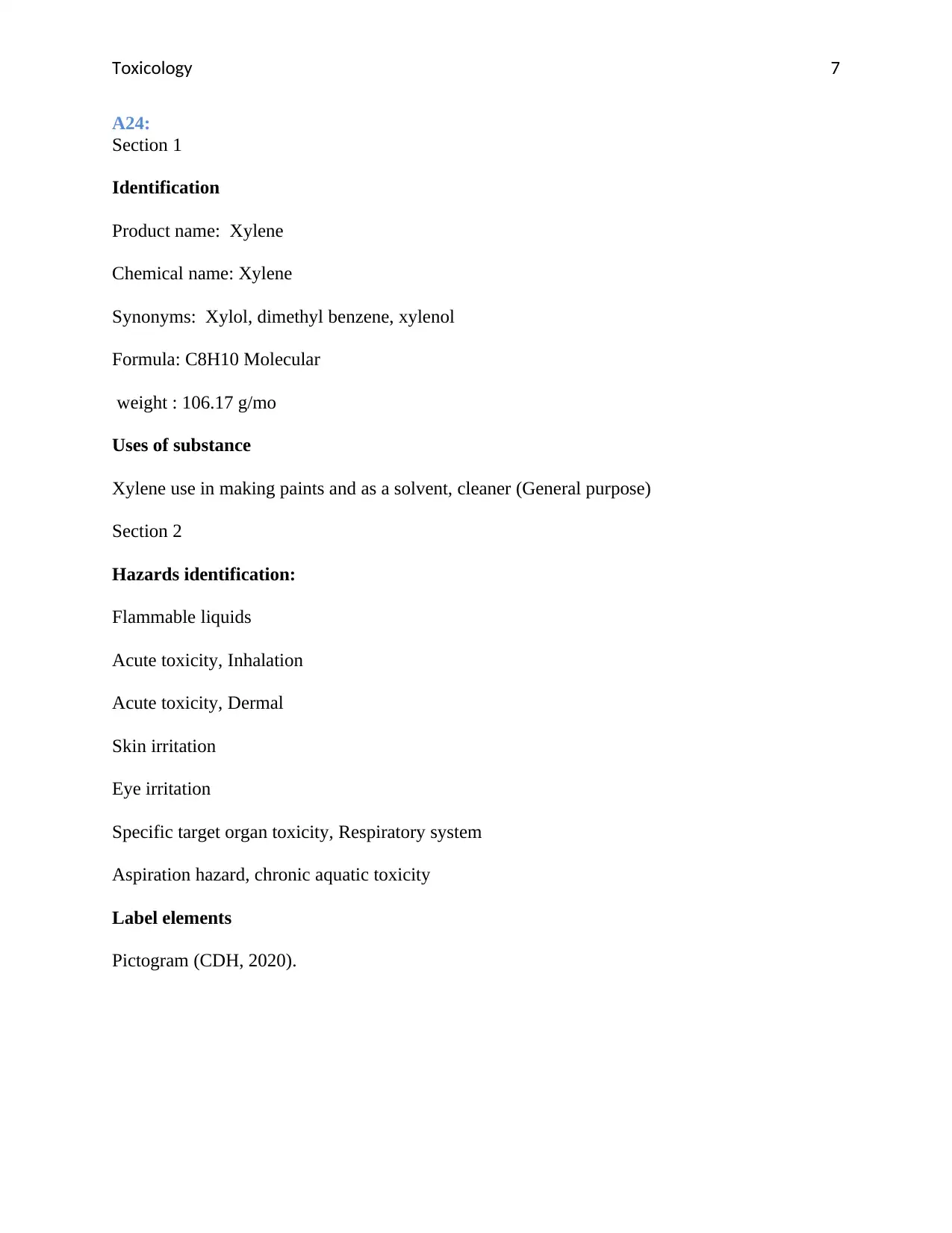
Toxicology 7
A24:
Section 1
Identification
Product name: Xylene
Chemical name: Xylene
Synonyms: Xylol, dimethyl benzene, xylenol
Formula: C8H10 Molecular
weight : 106.17 g/mo
Uses of substance
Xylene use in making paints and as a solvent, cleaner (General purpose)
Section 2
Hazards identification:
Flammable liquids
Acute toxicity, Inhalation
Acute toxicity, Dermal
Skin irritation
Eye irritation
Specific target organ toxicity, Respiratory system
Aspiration hazard, chronic aquatic toxicity
Label elements
Pictogram (CDH, 2020).
A24:
Section 1
Identification
Product name: Xylene
Chemical name: Xylene
Synonyms: Xylol, dimethyl benzene, xylenol
Formula: C8H10 Molecular
weight : 106.17 g/mo
Uses of substance
Xylene use in making paints and as a solvent, cleaner (General purpose)
Section 2
Hazards identification:
Flammable liquids
Acute toxicity, Inhalation
Acute toxicity, Dermal
Skin irritation
Eye irritation
Specific target organ toxicity, Respiratory system
Aspiration hazard, chronic aquatic toxicity
Label elements
Pictogram (CDH, 2020).
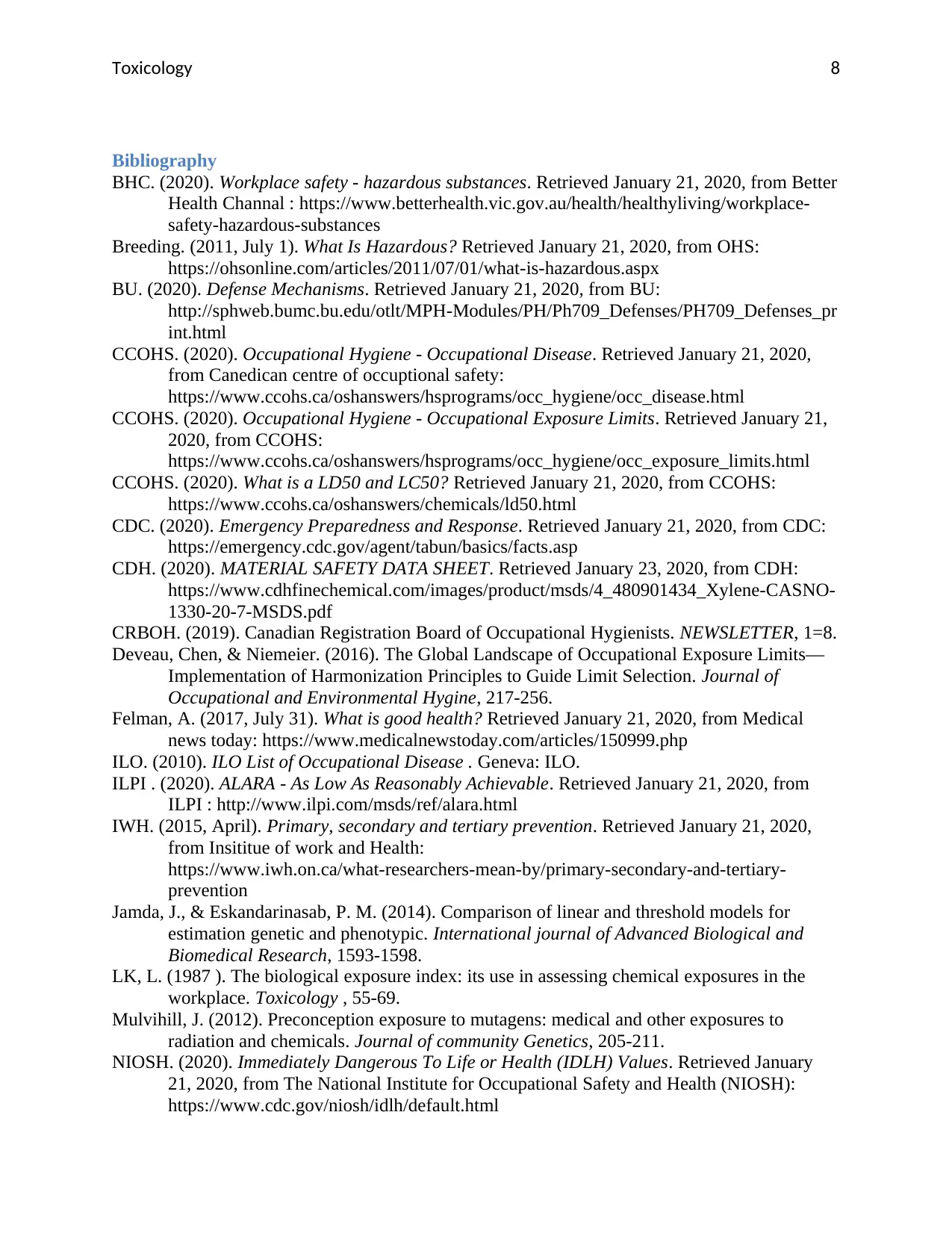
Toxicology 8
Bibliography
BHC. (2020). Workplace safety - hazardous substances. Retrieved January 21, 2020, from Better
Health Channal : https://www.betterhealth.vic.gov.au/health/healthyliving/workplace-
safety-hazardous-substances
Breeding. (2011, July 1). What Is Hazardous? Retrieved January 21, 2020, from OHS:
https://ohsonline.com/articles/2011/07/01/what-is-hazardous.aspx
BU. (2020). Defense Mechanisms. Retrieved January 21, 2020, from BU:
http://sphweb.bumc.bu.edu/otlt/MPH-Modules/PH/Ph709_Defenses/PH709_Defenses_pr
int.html
CCOHS. (2020). Occupational Hygiene - Occupational Disease. Retrieved January 21, 2020,
from Canedican centre of occuptional safety:
https://www.ccohs.ca/oshanswers/hsprograms/occ_hygiene/occ_disease.html
CCOHS. (2020). Occupational Hygiene - Occupational Exposure Limits. Retrieved January 21,
2020, from CCOHS:
https://www.ccohs.ca/oshanswers/hsprograms/occ_hygiene/occ_exposure_limits.html
CCOHS. (2020). What is a LD50 and LC50? Retrieved January 21, 2020, from CCOHS:
https://www.ccohs.ca/oshanswers/chemicals/ld50.html
CDC. (2020). Emergency Preparedness and Response. Retrieved January 21, 2020, from CDC:
https://emergency.cdc.gov/agent/tabun/basics/facts.asp
CDH. (2020). MATERIAL SAFETY DATA SHEET. Retrieved January 23, 2020, from CDH:
https://www.cdhfinechemical.com/images/product/msds/4_480901434_Xylene-CASNO-
1330-20-7-MSDS.pdf
CRBOH. (2019). Canadian Registration Board of Occupational Hygienists. NEWSLETTER, 1=8.
Deveau, Chen, & Niemeier. (2016). The Global Landscape of Occupational Exposure Limits—
Implementation of Harmonization Principles to Guide Limit Selection. Journal of
Occupational and Environmental Hygine, 217-256.
Felman, A. (2017, July 31). What is good health? Retrieved January 21, 2020, from Medical
news today: https://www.medicalnewstoday.com/articles/150999.php
ILO. (2010). ILO List of Occupational Disease . Geneva: ILO.
ILPI . (2020). ALARA - As Low As Reasonably Achievable. Retrieved January 21, 2020, from
ILPI : http://www.ilpi.com/msds/ref/alara.html
IWH. (2015, April). Primary, secondary and tertiary prevention. Retrieved January 21, 2020,
from Insititue of work and Health:
https://www.iwh.on.ca/what-researchers-mean-by/primary-secondary-and-tertiary-
prevention
Jamda, J., & Eskandarinasab, P. M. (2014). Comparison of linear and threshold models for
estimation genetic and phenotypic. International journal of Advanced Biological and
Biomedical Research, 1593-1598.
LK, L. (1987 ). The biological exposure index: its use in assessing chemical exposures in the
workplace. Toxicology , 55-69.
Mulvihill, J. (2012). Preconception exposure to mutagens: medical and other exposures to
radiation and chemicals. Journal of community Genetics, 205-211.
NIOSH. (2020). Immediately Dangerous To Life or Health (IDLH) Values. Retrieved January
21, 2020, from The National Institute for Occupational Safety and Health (NIOSH):
https://www.cdc.gov/niosh/idlh/default.html
Bibliography
BHC. (2020). Workplace safety - hazardous substances. Retrieved January 21, 2020, from Better
Health Channal : https://www.betterhealth.vic.gov.au/health/healthyliving/workplace-
safety-hazardous-substances
Breeding. (2011, July 1). What Is Hazardous? Retrieved January 21, 2020, from OHS:
https://ohsonline.com/articles/2011/07/01/what-is-hazardous.aspx
BU. (2020). Defense Mechanisms. Retrieved January 21, 2020, from BU:
http://sphweb.bumc.bu.edu/otlt/MPH-Modules/PH/Ph709_Defenses/PH709_Defenses_pr
int.html
CCOHS. (2020). Occupational Hygiene - Occupational Disease. Retrieved January 21, 2020,
from Canedican centre of occuptional safety:
https://www.ccohs.ca/oshanswers/hsprograms/occ_hygiene/occ_disease.html
CCOHS. (2020). Occupational Hygiene - Occupational Exposure Limits. Retrieved January 21,
2020, from CCOHS:
https://www.ccohs.ca/oshanswers/hsprograms/occ_hygiene/occ_exposure_limits.html
CCOHS. (2020). What is a LD50 and LC50? Retrieved January 21, 2020, from CCOHS:
https://www.ccohs.ca/oshanswers/chemicals/ld50.html
CDC. (2020). Emergency Preparedness and Response. Retrieved January 21, 2020, from CDC:
https://emergency.cdc.gov/agent/tabun/basics/facts.asp
CDH. (2020). MATERIAL SAFETY DATA SHEET. Retrieved January 23, 2020, from CDH:
https://www.cdhfinechemical.com/images/product/msds/4_480901434_Xylene-CASNO-
1330-20-7-MSDS.pdf
CRBOH. (2019). Canadian Registration Board of Occupational Hygienists. NEWSLETTER, 1=8.
Deveau, Chen, & Niemeier. (2016). The Global Landscape of Occupational Exposure Limits—
Implementation of Harmonization Principles to Guide Limit Selection. Journal of
Occupational and Environmental Hygine, 217-256.
Felman, A. (2017, July 31). What is good health? Retrieved January 21, 2020, from Medical
news today: https://www.medicalnewstoday.com/articles/150999.php
ILO. (2010). ILO List of Occupational Disease . Geneva: ILO.
ILPI . (2020). ALARA - As Low As Reasonably Achievable. Retrieved January 21, 2020, from
ILPI : http://www.ilpi.com/msds/ref/alara.html
IWH. (2015, April). Primary, secondary and tertiary prevention. Retrieved January 21, 2020,
from Insititue of work and Health:
https://www.iwh.on.ca/what-researchers-mean-by/primary-secondary-and-tertiary-
prevention
Jamda, J., & Eskandarinasab, P. M. (2014). Comparison of linear and threshold models for
estimation genetic and phenotypic. International journal of Advanced Biological and
Biomedical Research, 1593-1598.
LK, L. (1987 ). The biological exposure index: its use in assessing chemical exposures in the
workplace. Toxicology , 55-69.
Mulvihill, J. (2012). Preconception exposure to mutagens: medical and other exposures to
radiation and chemicals. Journal of community Genetics, 205-211.
NIOSH. (2020). Immediately Dangerous To Life or Health (IDLH) Values. Retrieved January
21, 2020, from The National Institute for Occupational Safety and Health (NIOSH):
https://www.cdc.gov/niosh/idlh/default.html
⊘ This is a preview!⊘
Do you want full access?
Subscribe today to unlock all pages.

Trusted by 1+ million students worldwide
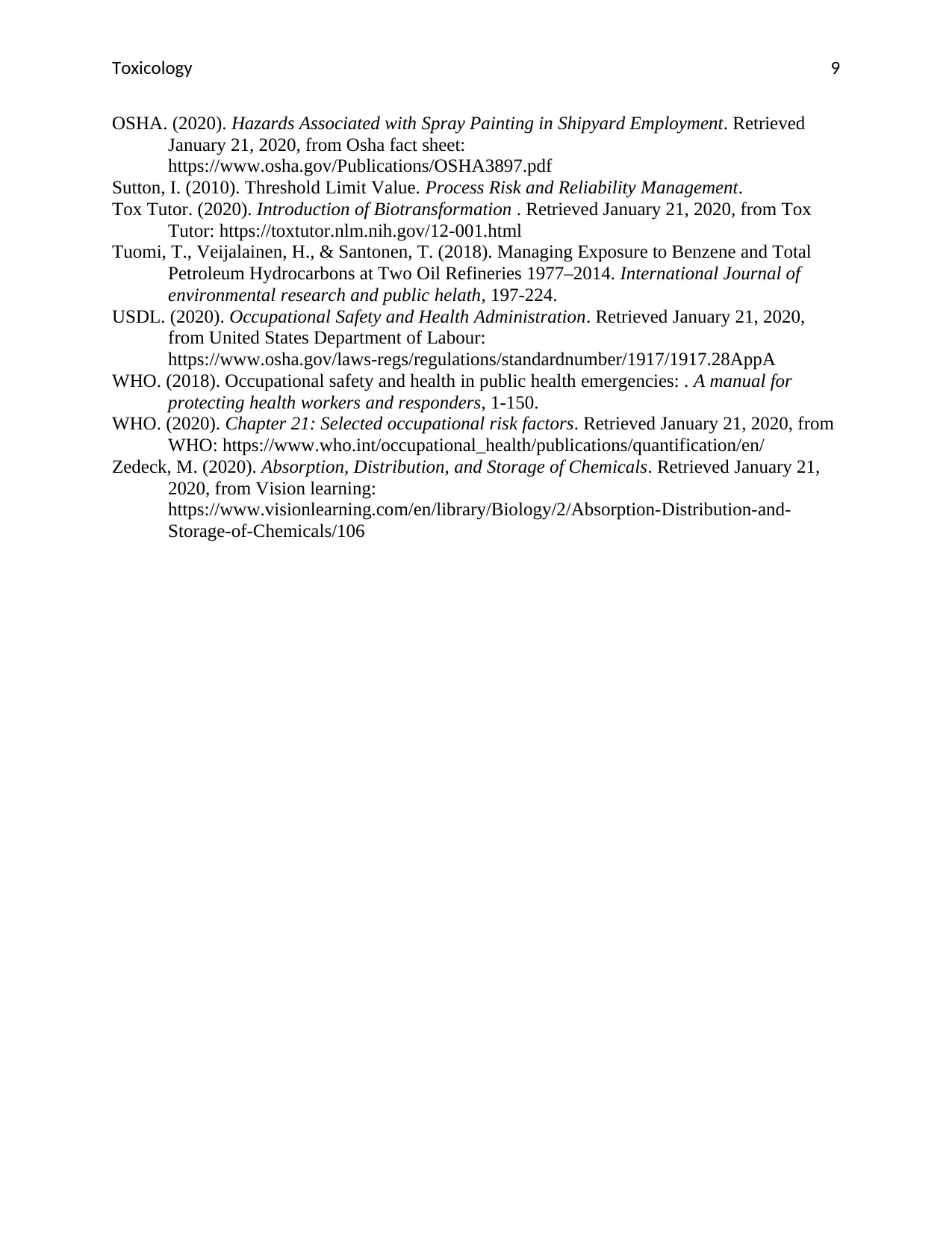
Toxicology 9
OSHA. (2020). Hazards Associated with Spray Painting in Shipyard Employment. Retrieved
January 21, 2020, from Osha fact sheet:
https://www.osha.gov/Publications/OSHA3897.pdf
Sutton, I. (2010). Threshold Limit Value. Process Risk and Reliability Management.
Tox Tutor. (2020). Introduction of Biotransformation . Retrieved January 21, 2020, from Tox
Tutor: https://toxtutor.nlm.nih.gov/12-001.html
Tuomi, T., Veijalainen, H., & Santonen, T. (2018). Managing Exposure to Benzene and Total
Petroleum Hydrocarbons at Two Oil Refineries 1977–2014. International Journal of
environmental research and public helath, 197-224.
USDL. (2020). Occupational Safety and Health Administration. Retrieved January 21, 2020,
from United States Department of Labour:
https://www.osha.gov/laws-regs/regulations/standardnumber/1917/1917.28AppA
WHO. (2018). Occupational safety and health in public health emergencies: . A manual for
protecting health workers and responders, 1-150.
WHO. (2020). Chapter 21: Selected occupational risk factors. Retrieved January 21, 2020, from
WHO: https://www.who.int/occupational_health/publications/quantification/en/
Zedeck, M. (2020). Absorption, Distribution, and Storage of Chemicals. Retrieved January 21,
2020, from Vision learning:
https://www.visionlearning.com/en/library/Biology/2/Absorption-Distribution-and-
Storage-of-Chemicals/106
OSHA. (2020). Hazards Associated with Spray Painting in Shipyard Employment. Retrieved
January 21, 2020, from Osha fact sheet:
https://www.osha.gov/Publications/OSHA3897.pdf
Sutton, I. (2010). Threshold Limit Value. Process Risk and Reliability Management.
Tox Tutor. (2020). Introduction of Biotransformation . Retrieved January 21, 2020, from Tox
Tutor: https://toxtutor.nlm.nih.gov/12-001.html
Tuomi, T., Veijalainen, H., & Santonen, T. (2018). Managing Exposure to Benzene and Total
Petroleum Hydrocarbons at Two Oil Refineries 1977–2014. International Journal of
environmental research and public helath, 197-224.
USDL. (2020). Occupational Safety and Health Administration. Retrieved January 21, 2020,
from United States Department of Labour:
https://www.osha.gov/laws-regs/regulations/standardnumber/1917/1917.28AppA
WHO. (2018). Occupational safety and health in public health emergencies: . A manual for
protecting health workers and responders, 1-150.
WHO. (2020). Chapter 21: Selected occupational risk factors. Retrieved January 21, 2020, from
WHO: https://www.who.int/occupational_health/publications/quantification/en/
Zedeck, M. (2020). Absorption, Distribution, and Storage of Chemicals. Retrieved January 21,
2020, from Vision learning:
https://www.visionlearning.com/en/library/Biology/2/Absorption-Distribution-and-
Storage-of-Chemicals/106
1 out of 10
Related Documents
Your All-in-One AI-Powered Toolkit for Academic Success.
+13062052269
info@desklib.com
Available 24*7 on WhatsApp / Email
![[object Object]](/_next/static/media/star-bottom.7253800d.svg)
Unlock your academic potential
Copyright © 2020–2025 A2Z Services. All Rights Reserved. Developed and managed by ZUCOL.





